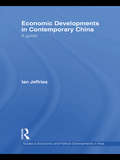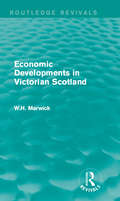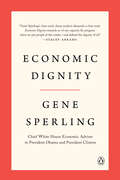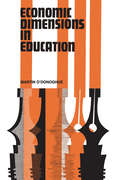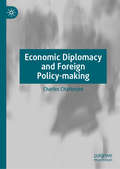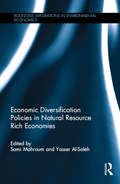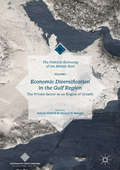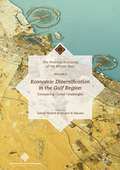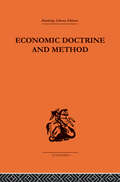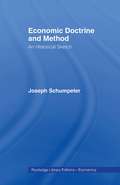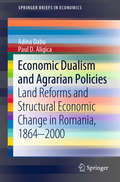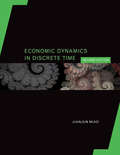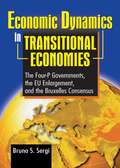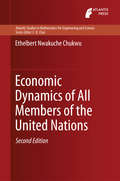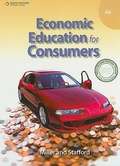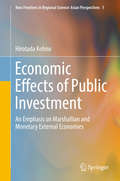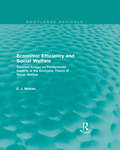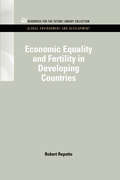- Table View
- List View
Economic Development: The History of an Idea
by H.W. Arndt"Economic Development makes an important contribution of the literature on economic development, especially as it incorporates ideas on a theme that informs our concern for social justice, individual and social freedom, identify, and community."—Winston E. Langley, Annals of the American Academy of Political and Social Science
Economic Developments in Contemporary China: A Guide (Guides to Economic and Political Developments in Asia)
by Ian JeffriesChina’s role in global affairs today continues to rise. This book provides an authoritative, comprehensive and detailed overview of contemporary economic developments in China. Key topics include agriculture; the market gradually replacing central planning; the global financial crisis; the reform of state-owned industrial enterprises; the non-state sectors; the ‘open-door’ policy (including the WTO, exchange rate policy, and inward and outward direct foreign investment); and China’s economic performance in general. The book continues - and adds to – the overview of developments up to May 2006 which were covered in the author’s China: A Guide to Economic and Political Developments (2006), and is the companion volume to Political Developments in Contemporary China: A Guide (2010) - both published by Routledge.
Economic Developments in Victorian Scotland (Routledge Revivals)
by W.H. MarwickMarwick argues that economic development in Scotland was severely delayed until the 18th Century unlike neighbouring countries. Originally published in 1936, this study aims to explore key features of economic development in Victorian Scotland to promote more understanding of this issue. Issues discussed include ownership of land and capital, administration and finances of industry, organisation of trade and marketing, labour and recruitment, trade unions, housing and other aspects which impact on the standard of life. This title will be of interest to students of Economics and Industrial History.
Economic Dignity
by Gene SperlingFrom one of our wisest and most influential economic thinkers, the only person to serve as Director of the National Economic Council under two Presidents, a profound big-picture vision of why the promotion of dignity should be the singular end goal by which we chart America's economic futureWhen Gene Sperling was in charge of coordinating the shaping and execution of the US government's economic policy in the Obama White House, he found himself surprised and dismayed when serious people in Washington worried out loud to him that the Obama focus on health care was a distraction because it was "not focused on the economy." How, he asked, was millions of Americans' fear that they were a single pink slip or a loved one's serious illness away from financial ruin somehow not considered an economic issue? To him, it was just one more example of a more profound truth he witnessed in his many years in our national economic debate: that when it comes to America's economic policy, there is too little focus on what the end goal should be.Too often, he found that our economic debate confused ends and means; that we measured economic success by metrics like GDP instead of whether the economy was succeeding in lifting up the sense of meaning, purpose, fulfillment, and security of people. Too often, he found debates framed by old divisions or pro-market ideology that increasingly failed to capture whether economic policy was fostering exploitation, economic insecurity, and disillusionment that were too often invisible within our current framework. Now more than ever, at a moment when the very capacity of modern capitalism to avoid accelerating inequality, a hollowed-out middle class, and structural poverty is being questioned, we need to step back and reflect on our ultimate goals.Economic Dignity is Sperling's effort to do just that - to frame our thinking about the way forward in a time of wrenching economic change. His argument combines moral and intellectual seriousness with actual high-level policy experience. Economic dignity, Sperling maintains, can be seen as resting on three pillars. The first: the capacity to care for family without economic deprivation denying people the capacity to experience its greatest joys - the birth of one's children, the companionship of a loving partner, the love of family and friends, the fulfillment that comes from providing. The second: the right to the pursuit of potential and purpose, including the right to first and second chances - the right to a life of active striving. The third: economic participation with respect and without domination and humiliation. All three pillars are rooted in the highest and most noble values of the American project. But getting there is the rub, and in Economic Dignity, Sperling offers paths that policymakers and citizens can follow for years to come. As he puts it, if you live in times when major steps forward are needed, it is important to be clear on your destination - or at least to know the North Star that is guiding you. His answer, in two words, is economic dignity.
Economic Dimensions in Education
by Martin O'DonoghueThis book examines the economic issues of education from an unusually systematic and broad perspective. Although the book is soundly based in economic theory, it is not heavily mathematical.Economic Dimensions in Education is designed to provide an introductory analysis of economic issues in education both in academic life and in the general community. Some of the issues discussed include the nature and reasons for public sector activity in education, the role education plays in providing skilled human resources for an economy, and the economic consequences of migration between countries of educated peoples. The book also deals with various aspects of demand: patterns of educational demand, individual demand for education as a form of social investment for the community, and supply aspects of education as related to types and sizes of educational establishments and problems of ensuring the efficient provision of education.There has been a growing interest in the economic aspects of education. The considerable growth in the volume of educational activity is now at the point where today education is one of the largest industries in most countries and also one of the chief employers of highly skilled personnel. The recognition that education may have a significant influence on the employment and income opportunities and hence affect the distribution of income and wealth in society is also a factor. A final reason stems from the post-war emphasis on economic growth and development, with education playing an important role as a provider of skilled personnel for an economy.This classic volume is comprehensive, clearly written, and will appeal to undergraduates and first-year graduate students. The treatment is firmly embedded in economic theory and is must reading for those professional economists concerned with education.
Economic Dimensions of Personalized and Precision Medicine (National Bureau of Economic Research Conference Report)
by John Rowe Ernst R. Berndt Dana P. GoldmanPersonalized and precision medicine (PPM)—the targeting of therapies according to an individual’s genetic, environmental, or lifestyle characteristics—is becoming an increasingly important approach in health care treatment and prevention. The advancement of PPM is a challenge in traditional clinical, reimbursement, and regulatory landscapes because it is costly to develop and introduces a wide range of scientific, clinical, ethical, and socioeconomic issues. PPM raises a multitude of economic issues, including how information on accurate diagnosis and treatment success will be disseminated and who will bear the cost; changes to physician training to incorporate genetics, probability and statistics, and economic considerations; questions about whether the benefits of PPM will be confined to developed countries or will diffuse to emerging economies with less developed health care systems; the effects of patient heterogeneity on cost-effectiveness analysis; and opportunities for PPM’s growth beyond treatment of acute illness, such as prevention and reversal of chronic conditions. This volume explores the intersection of the scientific, clinical, and economic factors affecting the development of PPM, including its effects on the drug pipeline, on reimbursement of PPM diagnostics and treatments, and on funding of the requisite underlying research; and it examines recent empirical applications of PPM.
Economic Diplomacy and Foreign Policy-making
by Charles ChatterjeeThis book aims to identify what components are needed for economic diplomacy in today’s rapidly changing world, looking at the nature, focus and tenets of economic diplomacy, and the differences between economic diplomacy and commercial diplomacy. Further, it considers the new kind of diplomacy that will be required for emerging markets, in contrast to maintaining the traditional techniques used for economic diplomacy between states. The author emphasises the negotiating techniques necessary for successfully engaging in economic diplomacy in the current diplomatic atmosphere. Importantly, it also discusses how to pursue economic diplomacy at international fora and with regard to private foreign investments. Lastly, it addresses the role of non-governmental organisations in economic diplomacy. Given its scope, the book will benefit not only practicing diplomats, but also graduate students.
Economic Discrimination and Political Exchange: World Political Economy in the 1930s and 1980s (Princeton Studies in International History and Politics #191)
by Kenneth A. OyeDid bilateral and regional bargaining choke off international commerce and finance in the 1930s and prolong the Great Depression? Is the open world economic system now being placed at risk by explicitly discriminatory practices that erode respect for the GATT, the IMF, and the IBRD? Most political economists would answer in the affirmative, warning that bilateral and regional preferences are at best inefficient and at worst catastrophic. By contrast, Kenneth Oye shows how economic discrimination can foster international economic openness by facilitating political exchange.
Economic Dislocation and Recovery in Lebanon (EPub)
by Jose Martelino Sena Eken S. Nuri Erbas Paul Cashin Adnan MazareiThis paper provides background information on the Lebanese economy, based on an analysis of the economic consequences of war, and discusses several issues that will be central to Lebanon's prospects for recovery
Economic Diversification Policies in Natural Resource Rich Economies (Routledge Explorations in Environmental Economics)
by Sami Mahroum Yasser Al-SalehEconomic diversification remains at the top of the agenda for hundreds of regions around the world. From the single commodity economies of African countries and the Caribbean, to the many single industry regions of Europe and North America, as well as the oil and gas rich but volatile hydrocarbon economies. Economic diversification policies have been around for almost a century with varying degrees of success and failure. Economic Diversification Policies in Natural Resource Rich Economies takes a special interest in the policy experiences of a set of different countries that have extractive industries representing significant drivers of their economies and subsequently are significant contributors to government revenues. It explores twelve cases including upper-middle to high income economies such as Canada, Australia, Iceland and Norway, emerging economies such as Latin America, the GCC (Saudi and UAE), Kazakhstan, Malaysia and Russia, as well as the developing economy of Uganda. Each chapter provides a review of economic diversification experiences including policy environment, diversification strategies, desired outcomes, the role of government, and a critical evaluation of achievements. This book is suitable for those who study environmental economics, development economics and resource management.
Economic Diversification in the Gulf Region, Volume I
by Ashraf Mishrif Yousuf Al BalushiThis volume focuses on the role of the private sector in diversifying the economics of Gulf countries in the post-petrodollar era, when fluctuating and declining oil prices are negatively impacting national expenditures. It explores current policies of countries in the Gulf Cooperation Council and their efforts to shift their economies away from heavy dependence on hydrocarbons. The structural changes will create favorable conditions for the private sector to flourish, shift production dependence from public to private sector, and allow for more efficient resource allocation. Such changes will also allow local banks to provide financial support to small and medium enterprises, boost entrepreneurship for job creation, and strengthen organizational structure and efficiency. This is the first volume in Economic Diversification in the Gulf Region.
Economic Diversification in the Gulf Region, Volume II
by Ashraf Mishrif Yousuf Al BalushiThis volume explores the challenges to diversification in Gulf countries, which can no longer rely on profits from hydrocarbons to fund national expenditures. It elaborates on the problem of weak institutions, lack of coordination between policy makers and executors, limited investment in research and development, and a workforce that is too poorly skilled to compete in the private sector. In addition to analyzing issues in areas such as education, labor, business, and trade, the contributors underscore the importance of using global best practices to overcome fundamental weaknesses in the Gulf Cooperative Council's economic structure that limit opportunities for economic diversification.This is the second volume in Economic Diversification in the Gulf Region.
Economic Doctrine and Method: An Historical Sketch
by Joseph Schumpeter'The translation of these essays is a testimony to Professor Schumpeter's power in the analysis of economic thinking' The Financial Times.This classic book is divided into four sections. The first gives a broad survey of economic thought from the days of Aristotle to the beginnings of modern times, and the second traces the development of the conception of the circular flow of economic forces. The third and fourth sections cover the main theorems of the classical economists and describe the genesis of the school of marginal utility.
Economic Doctrine and Method: An Historical Sketch
by Joseph schumpeterFirst published in 2007. Routledge is an imprint of Taylor & Francis, an informa company.
Economic Dualism and Agrarian Policies: Land Reforms and Structural Economic Change in Romania, 1864–2000 (SpringerBriefs in Economics)
by Adina Dabu Paul D. AligicaThis book offers an in-depth case study of Romania’s land and agricultural reforms from mid-19th century and up to 2000, offering a historical account of agricultural reforms in post-communist Romania in the light of more than a century of social and economic development experiments. Taking a ‘dual economy’ analytic perspective, the book examines the impact of structural and agricultural reforms on the country's economic development and provides an analysis of the ideas and models that stood behind policy reforms aiming at the modernization of an economy and society defined by dualism and late development.
Economic Dynamics in Discrete Time, second edition
by Jianjun MiaoA unified and comprehensive introduction to the analytical and numerical tools for solving dynamic economic problems; substantially revised for the second edition.This book offers a unified, comprehensive, and up-to-date treatment of analytical and numerical tools for solving dynamic economic problems. The focus is on introducing recursive methods—an important part of every economist's set of tools—and readers will learn to apply recursive methods to a variety of dynamic economic problems. The book is notable for its combination of theoretical foundations and numerical methods. Each topic is first described in theoretical terms, with explicit definitions and rigorous proofs; numerical methods and computer codes to implement these methods follow. Drawing on the latest research, the book covers such cutting-edge topics as asset price bubbles, recursive utility, robust control, policy analysis in dynamic New Keynesian models with the zero lower bound on interest rates, and Bayesian estimation of dynamic stochastic general equilibrium (DSGE) models. This second edition has been substantially updated. Responding to renewed interest in modeling with multiple equilibria, it incorporates new material on this topic throughout. It offers an entirely new chapter on deterministic nonlinear systems, and provides new material on such topics as linear planar systems, chaos, bifurcations, indeterminacy and sunspot solutions, pruning nonlinear solutions, the bandit problem, rational inattention models, bequests, self-fulfilling prophecies, the cyclical behavior of unemployment and vacancies, and the long-run risk model. The exposition of each chapter has been revised and improved, and many new figures, Matlab codes, and exercises have been added. A student solutions manual can be purchased separately.
Economic Dynamics in Transitional Economies: The Four-P Governments, the EU Enlargement, and the Bruxelles Consensus
by Bruno SergiLearn more about the transitional economies of Central and Eastern Europe! This book examines the economic dynamics of Central and Eastern European post-Communist countries. It illuminates the paths these countries are taking toward restructuring their markets, increasing international trade, and bettering their connections with the European Union and other countries. Beginning with a comparative analysis of the three "P-governments"-Pigouvian, Partizan, and Paternalistic-and continuing with a discussion of the interrelated political and economic difficulties of transition, author Bruno Sergi proposes a surprising solution. Inspired by the Bruxelles consensus, he proposes that the European Commission should become a fourth "P-government," replacing the role formerly played by the Washington consensus in the restructuring of post-Communist economies. Economic Dynamics in Transitional Economies also explores: regional comparative macroeconomics the aftereffects of the Washington Consensus integration of Eastern and Western European economies interrelations between national and regional monetary activity political and economic policy reform involvement of European Union member countries We are living in historic times, and Economic Dynamics in Transitional Economies will be a welcome guide to the rough roads ahead. This thorough assessment of current political and economic realities will stimulate debate about new European paradigms, the role of the European Union, and the difficulties of post-Communist transition. These issues promise to be vital to the region&’s success in the new century.
Economic Dynamics of All Members of the United Nations
by Ethelbert Nwakuche ChukwuThis book provides an enduring response to modern economic problems and the consequent crises, dealing with the economic modelling of nations and the forecasting of economic growth. The main arguments embodied constitute the creation of jobs and the restoration of economic growth, using the implicit acceptance of analysis on differential models and neutral systems for controlling the wealth of nations.
Economic Dynamics, second edition: Theory and Computation
by John StachurskiThe second edition of a rigorous and example-driven introduction to topics in economic dynamics that emphasizes techniques for modeling dynamic systems.This text provides an introduction to the modern theory of economic dynamics, with emphasis on mathematical and computational techniques for modeling dynamic systems. Written to be both rigorous and engaging, the book shows how sound understanding of the underlying theory leads to effective algorithms for solving real-world problems. The material makes extensive use of programming examples to illustrate ideas, bringing to life the abstract concepts in the text. Key topics include algorithms and scientific computing, simulation, Markov models, and dynamic programming. Part I introduces fundamentals and part II covers more advanced material. This second edition has been thoroughly updated, drawing on recent research in the field.New for the second edition: &“Programming-language agnostic&” presentation using pseudocode.New chapter 1 covering conceptual issues concerning Markov chains such as ergodicity and stability.New focus in chapter 2 on algorithms and techniques for program design and high-performance computing.New focus on household problems rather than optimal growth in material on dynamic programming.Solutions to many exercises, code, and other resources available on a supplementary website.
Economic Education for Consumers
by Roger Leroy Miller Alan D. StaffordECONOMIC EDUCATION FOR CONSUMERS, 4E brings economic, consumer, and personal finance topics to life. Exciting changes to this edition include a bright, new design and updated information on important changes in technology, banking, and taxes. Organized into several class-length lessons, each chapter contains several features to capture and maintain student interest, such as Consumer Alert, Vote Your Wallet, Inside the Numbers, Math of Money, What in the World?, and NetBookmark.
Economic Effects of Public Investment
by Hirotada KohnoThis book shows the necessity of measuring the incidence-basis indirect economic effects of public investments. The essential argument can be traced back to H. Mohring versus J. Tinbergen, the conclusions of one contradicting those of the other. Their arguments are called, respectively, "transfer" and "existing theory" of the indirect economic effect of public investments such as highways. The author has first defined the categories of "generation-basis" and "incidence-basis" economic effects in addition to the categories of direct and indirect economic effects, and has shown that it is essential to measure the incidence-basis indirect economic effects for decision making about public investments. The second major point is that, in this sense, the measurement must rely on the general and dynamic spatial modeling simulation approach. The third essential point is that Tinbergen is correct as far as we have to cope with a real setting in which the Marshallian type of external economies exists. Another characteristic is that the monetary (pecuniary) external economies are dealt with systematically, for the superiority of public investment criteria depends greatly on whether they are taken hold of or not. This book lays emphasis on the process toward the equilibrium, not the equilibrium itself.
Economic Effects of the Pandemic: Implications for the Economy, Finance and Tourism (The Political Economy of the Middle East)
by Ashraf MishrifThis book addresses the impact and implications of the COVID-19 pandemic, one of the most challenging public health risks to human wellbeing, on the economic activities and behaviors of Middle Eastern countries during and in the aftermath of the pandemic. It provides detailed examination of how the global and Middle Eastern economies incurred significant financial and economic damages, human losses, and hundreds of millions of people losing their jobs. The analysis of this book is entirely based on primary data and a mix of quantitative and qualitative research methods to accurately account for the effects of the pandemic on the economy, finance, and tourism. While providing in-depth analysis of the macro and micro economy at global and national levels, the book investigates the impact of the pandemic on human behavior including household and water consumptions in the GCC countries, as well as offering potential green strategies for sustainable recovery in the post-pandemic era. As well as explaining the negative effects of the pandemic on the tourism and hospitality industries, the book also offers some positive outcomes from the pandemic, most notably in the innovation and IT sector and creative approaches in banking practices and services to ensure financial stability and sufficient liquidity in the market. Readers, students, researchers, industry practitioners and policy makers will benefit from the new insights offered by a diverse group of senior researchers and experts from across the world.
Economic Efficiency and Social Welfare: Selected Essays on Fundamental Aspects of the Economic Theory of Social Welfare (Routledge Revivals)
by E. J. MishanFirst published in 1981, Professor Mishan’s Economic Efficiency and Social Welfare: Selected Essays on Fundamental Aspects of the Economic Theory of Social Welfare is a collection of 22 pioneering essays written while the author was teaching at the London School of Economics and chosen to indicate landmarks in the development of his own thought. Professor Mishan, who also enjoys an international reputation as a popular writer on the impact of modern economic growth on social welfare, is among the foremost authorities in the field of resource allocation, and his influence in his subject area has been profound. Mishan’s essays, while generally accessible to the layman due to the author’s lucidity, his economy in the use of mathematical notation and his concern with perspective, are invaluable reading for the economics undergraduate. The essays are particularly relevant to upper level students of project appraisal, welfare economics and cost benefit analysis requiring a coherent survey of their field of study.
Economic Elites, Political Parties and the Electoral Arena: Argentina, Chile and Uruguay in Comparative Perspective (Latin American Political Economy)
by Felipe MonestierThis book delves into the intricate dynamics between economic elites and the political party system in Argentina, Chile, and Uruguay, particularly during their democratization phases in the twentieth century. It introduces a novel framework for comprehending the diverse political strategies adopted by these countries’ economic elites during this critical period. The central premise of this book is that the interplay between the cohesion of economic elites and the mobilization of popular sectors at specific historical junctures profoundly influences the nature of elite political involvement.While existing literature has extensively discussed the strategies employed by economic elites to safeguard their interests, this book takes a fresh approach by considering three primary configurations of relationships between economic elites and political parties. It explores cases where economic elites are the primary constituency of parties they have founded, as well as instances where upper-class interests are predominantly defended outside the party system through mechanisms such as the armed forces, pressure groups, and lobbying. Additionally, it examines scenarios where economic elites align themselves with parties boasting a polyclass constituency, exerting limited influence over these parties.This book goes beyond traditional analyses by proposing a theory that elucidates how the interaction between elite cohesion and popular sector mobilization determines the specific forms of elite political involvement. It also charts the historical sequences of this process, emphasizing the evolution of the causal relationship over time.To illustrate this theory, the book employs a comparative historical analysis, scrutinizing the three aforementioned cases to identify factors that account for the different forms of economic elite political participation. It discerns that the level of cohesion among economic elites and the degree of mobilization among popular sectors are pivotal factors shaping elite-party relationships.
Economic Equality and Fertility in Developing Countries (RFF Global Environment and Development Set)
by Robert RepettoThis book briefly reviews sociological, economic, and demographic literature pertaining to the relationship between income and fertility in developed and developing countries. He presents a conceptual framework to examine how fertility responds to changes in the distribution of household income. The analysis of data from Puerto Rico, Korea, and rural India is carefully executed, and conclusive policy implications are discussed. Originally published in 1979

